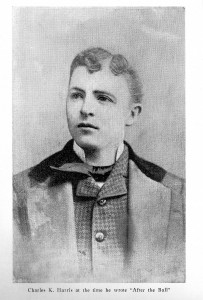CHAP. 1 – WHEN SONGS BECAME A BUSINESS

Charles K. Harris, at the time he wrote “After the Ball”
As I discuss in the book, few songs in American history have had the impact of Charles K. Harris’s “After the ball” of 1892-93. Although the lyrics tell the story of a love gone awry because of a case of mistaken identity, it was the lilting, easy-to-sing chorus, not the verses, that made this song the first modern “hit.” Indeed, many recordings of the song, such as this one by George J. Gaskin from ca. 1893, do not even include the third and final verse, in which the case of mistaken identity is revealed. (This exclusion was not due only to the limited duration of recordings, either. It is found on later recordings as well.) —
George J. Gaskin_After the Ball
Here’s a video of Charles K. Harris from the late 1920s talking about and singing the first verse and chorus of “After the Ball.” (Note that he apologizes for not having a voice as estimable as Caruso’s [at 0:47].) —
And here’s another pioneer of Tin Pan Alley, Harry Von Tilzer, discussing and demonstrating the need for simplicity in composing popular songs (also filmed in the late 1920s):
At the end of Chapter One, I discuss, Irving Berlin’s “Alexander’s Ragtime Band,” whose insistent chorus–“C’mon and hear! C’mon and hear!…”–called attention to the revolutionary aural phenomenon taking place in the transformation of popular song. Here’s a version of the song recorded in 1911 by Billy Murray, one of the leading popular performers in the phonograph business in the first two decades of the twentieth century:
Billy Murray_Alexanders Ragtime Band
Berlin’s follow-up to “Alexander’s Ragtime Band” was called “That Mysterious Rag.” It never achieved anything approaching the success of “Alexander’s Ragtime Band,” but it did resemble its predecessor in that its lyrics also called attention to the aural experience of popular music, which in this case was literally infectious. Here’s a recording of the song by the Premier Quartet (a.k.a. the American Quartet) from 1911:
Mysterious Rag
(Courtesy of the UCSB Cylinder Preservation and Digitization Project)
***
Return to the Sounds page